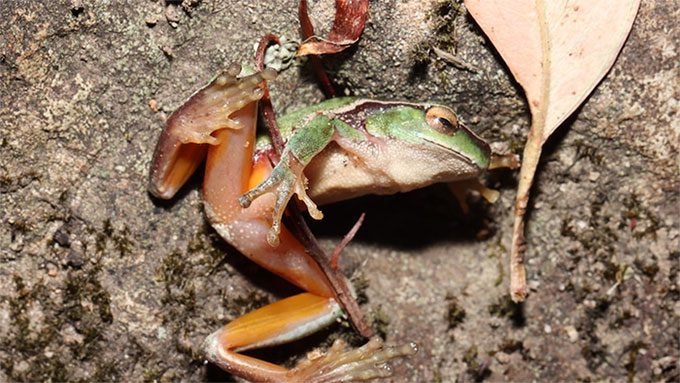Coal sludge has leaked and flowed into the Royal Botanic Garden in Australia multiple times throughout 2022, causing serious health impacts on the local green tree frog population that breathe through their skin near the contaminated areas.
According to reporters in Sydney, scientists Shannon Kaiser and Chad Beranek from Australia conducted surveys of the local frog populations to analyze the impact of foreign chemicals seeping into the freshwater ecosystem.

A green tree frog struggling near the Hacking River. (Source: ABC News).
The scientists noted that they observed signs of coal pollution in the Royal Botanic Garden when coal sludge leaked into nearby waterways and flowed into the park several times last year, and they found that the green tree frogs near the contaminated areas were severely affected in terms of health.
This alarming sign occurred at sites along the Hacking River, south of Sydney in New South Wales.
Surveys were conducted from September to December last year at Camp Gully Creek and the Hacking River, one of the main rivers flowing through the Royal Botanic Garden.
According to Mr. Kaiser, it is difficult to definitively conclude the relationship between the frogs’ poor health and coal pollution; however, this species is particularly sensitive and vulnerable to disturbances in their habitats due to their skin structure.
Any chemicals that enter the water can directly penetrate the frogs and cause severe harm. It is possible that coal sludge has reduced their immune response.
Mr. Kaiser added that there is currently a disease called chytridiomycosis (a type of fungus) that is killing frog species worldwide. Therefore, if this disease indeed exists in the area and coal sludge passes through, it could weaken the frogs’ immune systems, potentially leading to their death.
Meanwhile, according to the New South Wales Environmental Protection Authority (EPA), efforts to clean up contaminated water sources are ongoing, particularly downstream of the Hacking River.
An EPA spokesperson stated that the agency has collected water samples downstream from the discharge point since mid-2022 to analyze environmental impacts and provide information for investigations. The results indicate that there is no risk to human health.


















































